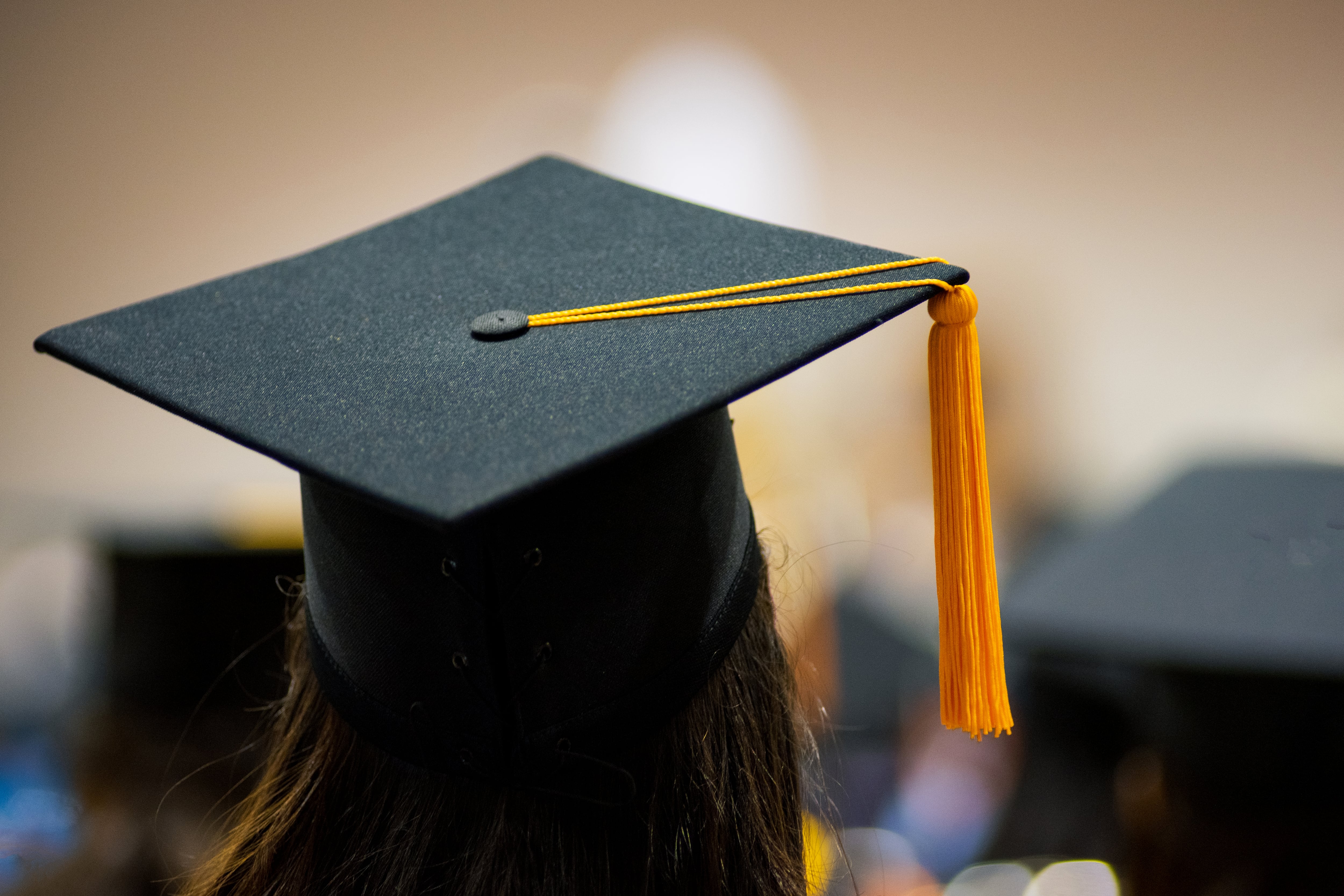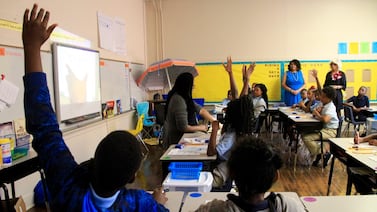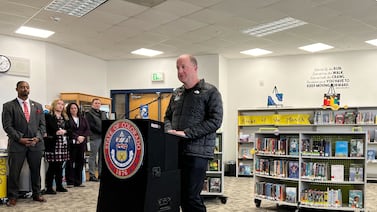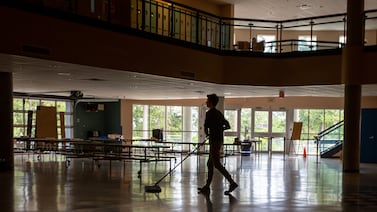In a rare bright spot for students whose senior year was fractured by the coronavirus, Indiana high schoolers in the class of 2020 graduated at about the same rate as those in the prior year.
But at a handful of Indiana schools serving some of the state’s highest-need students, graduation rates plummeted. At three Indianapolis high schools, leaders say that the challenges of the pandemic contributed to double-digit drops in graduation rates, as students struggled to complete school remotely or left school to get jobs.
Graduation rates are important because students who earn diplomas have opportunities for better-paying jobs and for higher education. The calculations also measure how well schools are educating their students.
The recent rates aren’t comparable with previous years, because the state effectively lowered the bar by suspending the graduation exam and loosening graduation requirements in 2020. State officials said students who were on track to graduate shouldn’t have their education derailed by the pandemic. But some students, particularly those already struggling, were unable to graduate within four years amid the challenges posed by the lockdowns.
Graduation rates fell by more than 10 percentage points at two of the four high schools operated by Indianapolis Public Schools. At George Washington High School, the graduation rate dropped to 63% in 2020. At Arsenal Technical High School, the district’s largest campus, the graduation rate fell to 69%.
Superintendent Aleesia Johnson attributed the dip to the pandemic, which denied students in-person connections with staff. When campuses closed, those schools struggled to keep students engaged, particularly students who were already “on the edge,” she said. Some students did not have computers to log in from home.
Johnson said there were definitely some gaps in reaching students and making sure that they finished. For example, the district has more students who are still working on credits needed to graduate, even after four years in high school.
“I attribute that to the fact that the level of engagement was just lower than what we’ve seen before once we were not seeing them in person every day,” Johnson said.
More than 65% of students at Tech and George Washington come from low-income families, who have suffered through a disproportionate financial strain during the pandemic.
The district was more successful at helping students graduate at its other two campuses, particularly Shortridge High School. In spite of the pandemic, the graduation rate at Shortridge jumped by nearly 8 percentage points, to reach 87%.
Shortridge Principal Dennis Thomas said that when the pandemic hit, nearly all juniors and seniors already had late-model MacBooks required for their visual arts and International Baccalaureate programs. And students were familiar with the district’s online platforms. This, he said, positioned them to weather the transition to remote learning more easily than those at other high schools.
At the onset of the pandemic, the district scrambled to ensure students had access to the internet and computers at home. Staff called families to check if high school students had the technology and internet for online learning. In April, the district gathered more than 6,000 devices to give to high school and middle school students in advanced classes. A survey revealed that just half of students were ready to learn remotely with technology at home.
Thomas also noted that school staff were aggressive about tracking student progress and checking in with seniors about whether they were on track to graduate.
District officials said George Washington and Arsenal Tech staff checked in consistently with students and provided support services. But both schools also had higher rates of students moving in and out of the schools and of students having to work to support families.
To keep students on track to graduate, last spring the district and schools deployed “success agents” who have met regularly with students and communicated with parents monthly, monitored attendance and academic progress, and documented meetings and supportive services, district officials said.
This school year, IPS high schoolers have gone back and forth between in-person and remote instruction. Currently, students are back on campus for part of each week.
Johnson hopes that reopening campuses will help academics and engagement.
“You can’t undervalue the power of those in-person touch points to be able to see kids and just really have a very clear sense of what’s happening,” Johnson said. “It makes a huge difference.”
Johnson said the district has some work to do to improve graduation rates at George Washington and Tech. This school year, the district has added graduation services to ensure students are on track and to find where they go when they leave, Johnson said.
Even in a normal year, graduation rates fluctuate, particularly at small schools where a handful of students dropping out can move the needle. Some of the Indiana schools with the largest declines told Chalkbeat the drops were unrelated to the pandemic. And graduation rates fell at several schools after the state audited whether students were properly marked as leaving to home school.
At the schools that saw dips because of the pandemic, practical barriers such as limited access to computers and the internet may have gotten in the way, said Russell Rumberger, a professor emeritus at the University of California, Santa Barbara.
“These were things that are kind of correctable,” Rumberger said. “Hopefully that means that next year, it should recover some.”
Rumberger cautioned, however, that even at schools where graduation rates held steady, students missed out on weeks of in-person instruction. Because of relaxed graduation requirements across the country, many students who earned diplomas may be unprepared for college.
That fear was top of mind for Christina Lear, the principal of Indianapolis Metropolitan High School, a west side charter school operated by Goodwill Education Initiatives. When the state allowed schools to give diplomas to students who were on track before the pandemic even if they didn’t do remote schoolwork, Indy Met leaders decided to keep their graduation expectations the same.
A diploma is more than a piece of paper, Lear said. Unprepared graduates may enroll in college, incur debt, and then fail classes. Or they may think they are not college material.
“I’m worried when students don’t graduate. That’s why we do this work, is because we want to see our students meet this milestone and then be ready for what is next,” Lear said. “But I am equally worried about kids that have a diploma ... that are not prepared.”
In part because of the decision to require students to complete work remotely, Indy Met had the largest drop in graduation rates in the state. About 61% of students in the class of 2020 graduated within four years — more than 20 percentage points lower than the year before.
Lear said she was already expecting a dip in the graduation rate because a few years ago, the school began to focus on serving students who struggled in other high schools, and those teens often take longer to graduate.
But remote school was harder for students, and there were some who had been on track before the pandemic who just couldn’t keep up, she said.
Lear said she felt better about the decision to keep requirements in place because the staff worked hard to help those students, providing devices and Wi-Fi hotspots, expanding summer school, and helping family members find jobs. And if students didn’t graduate, educators didn’t give up.
As an alternative school, Indy Met encourages students who are behind to stay for a fifth year. And Goodwill also operates Excel Centers, a network of adult high schools where students sometimes transfer. About a third of Indy Met students who were expected to graduate in 2020 remained in school, according to state data.
“It kept the integrity of our diploma at a level that aligns with our mission,” Lear said. “But we also knew that it wasn’t game over for those kids, because we already had these robust systems in place to continue them on into a fifth year if they needed it.”
Correction: Feb. 4, 2020: This story has been updated to remove a description of the student population at Shortridge, which serves a similar proportion of students from low-income families as George Washington and Arsenal Technical high schools.






